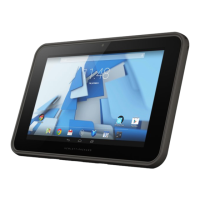There are two types of rewalls to consider:
●
Host-based rewalls—Software that protects only the tablet it is installed on.
●
Network-based rewalls—Installed between your DSL or cable modem and your home network to
protect all the tablets on the network.
When a rewall is installed on a system, all data sent to and from the system is monitored and compared with
a set of user-dened security criteria. Any data that does not meet those criteria is blocked.
Your tablet or networking equipment may already have a rewall installed. If not, rewall software solutions
are available.
NOTE: Under some circumstances a rewall can block access to Internet games, interfere with printer or le
sharing on a network, or block authorized e-mail attachments. To temporarily resolve the problem, disable
the rewall, perform the task that you want to perform, and then reenable the rewall. To permanently
resolve the problem, recongure the rewall.
Installing critical security updates
CAUTION: Microsoft® sends out alerts regarding critical updates. To protect the tablet from security
breaches and viruses, install all critical updates from Microsoft as soon as you receive an alert.
You can choose whether updates are installed automatically. To change the settings, type control panel
in the taskbar search box, and then select Control Panel. Select System and Security, select Windows
Update, select Change settings, and then follow the on-screen instructions.
Using TPM (select products only)
IMPORTANT: Before enabling Trusted Platform Module (TPM) functionality on this system, you must ensure
that your intended use of TPM complies with relevant local laws, regulations and policies, and approvals or
licenses must be obtained if applicable. For any compliance issues arising from your operation/usage of TPM
which violates the above mentioned requirement, you shall bear all the liabilities wholly and solely. HP will
not be responsible for any related liabilities.
TPM provides additional security for your tablet. You can modify the TPM settings in Computer Setup (BIOS).
The TPM setting is only displayed after you set a BIOS administrator password. For more information on
setting a password, see Managing a BIOS administrator password on page 24.
NOTE: If you change the TPM setting to Hidden, TPM is not visible in the operating system.
To access TPM settings in Computer Setup:
1. Turn o the tablet.
2. Press the power button and when the Press and hold the Volume down button or the ESC key on
external Keyboard to enter Startup Menu message displays, press the volume down button.
The Startup menu is displayed.
3. Tap F10 BIOS Setup.
4. Select Security, select TPM, and then follow the on-screen instructions.
26 Chapter 8 Security

